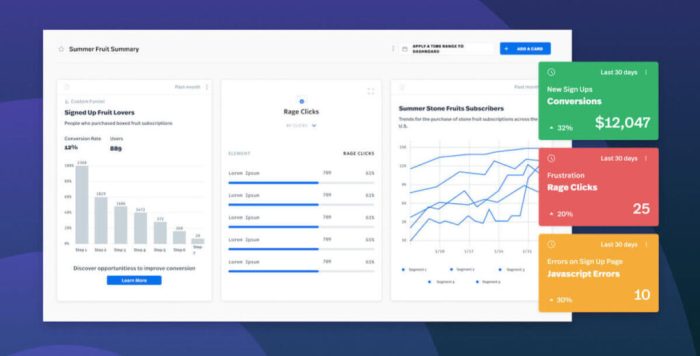Using Analytics to Improve UX takes center stage, inviting you into a realm of data-driven insights and user-centric design. Get ready to dive deep into the world of UX optimization!
Importance of UX Analytics
User Experience (UX) analytics play a crucial role in improving the overall experience of a website or application. By analyzing user behavior and interactions, businesses can make informed decisions to enhance usability, engagement, and satisfaction.
Uncovering User Behavior Patterns
- Analytics data can reveal how users navigate through a website, where they spend the most time, and what actions they take.
- By identifying patterns in user behavior, businesses can optimize the layout, content, and features to better meet the needs and preferences of their target audience.
- For example, heatmaps can show which areas of a webpage receive the most clicks, helping designers prioritize important elements and improve overall user flow.
Enhancing User Engagement
- Through analytics, businesses can track user engagement metrics such as bounce rate, session duration, and conversion rates.
- By understanding how users interact with a site, companies can tailor their strategies to increase engagement and encourage desired actions.
- For instance, A/B testing different layouts or CTAs based on analytics data can lead to significant improvements in conversion rates and overall user satisfaction.
Types of UX Analytics

When it comes to measuring user experience, there are various types of analytics that can provide valuable insights into how users interact with a website or app. These analytics help designers and developers make informed decisions to enhance the overall user experience.
Quantitative Analytics
Quantitative analytics involve numerical data and metrics that can be measured and analyzed. Examples of quantitative analytics include click-through rates, bounce rates, conversion rates, and time spent on a page. These metrics provide valuable information about user behavior and interactions on a website or app. For example, a high bounce rate may indicate that users are not finding the content they are looking for, prompting the need for a redesign or reorganization of the website layout.
Qualitative Analytics
Qualitative analytics, on the other hand, focus on understanding the “why” behind user behavior. This type of analytics involves gathering feedback through surveys, user testing, and heatmaps to gain insights into user needs, preferences, and pain points. Qualitative analytics can provide valuable context to quantitative data, helping designers and developers understand the motivations and emotions driving user interactions. For instance, user testing sessions can reveal usability issues that quantitative data alone may not capture, leading to targeted improvements that address specific user needs.
Implementing UX Analytics Tools

When it comes to improving user experience on a website or application, implementing the right UX analytics tools is crucial. These tools help in collecting and analyzing data to make informed decisions for enhancing the overall user experience.
Popular Tools for Collecting and Analyzing UX Data
There are several popular tools available for collecting and analyzing UX data. Some of the widely used tools include:
- Google Analytics: A powerful tool for tracking user behavior, site traffic, and conversion rates.
- Hotjar: Allows for heat mapping, session recordings, and user feedback to understand user interactions better.
- Crazy Egg: Provides heat maps, scroll maps, and click reports to visualize user behavior on a website.
Process of Integrating Analytics Tools
Integrating analytics tools into a website or application involves the following steps:
- Choose the right analytics tool based on your needs and objectives.
- Install the tracking code provided by the tool on all relevant pages of your website.
- Set up goals and events to track specific user interactions and conversions.
- Regularly monitor and analyze the data collected to make informed decisions for improving UX.
Best Practices for Setting Up Analytics Tracking
To ensure effective analytics tracking for improving UX, consider the following best practices:
- Define clear objectives and key performance indicators (KPIs) to measure the success of your UX improvements.
- Implement event tracking to monitor specific user interactions such as clicks, form submissions, or video views.
- Regularly review and analyze user feedback to identify pain points and areas for improvement in the user experience.
- Utilize A/B testing to experiment with different design elements and features to optimize user engagement and conversion rates.
Interpreting Analytics Data: Using Analytics To Improve UX
When it comes to interpreting analytics data for improving user experience, it’s essential to understand key metrics like bounce rate, session duration, and conversion rates. These metrics provide valuable insights into how users interact with your website or app.
Metrics Interpretation
- Bounce Rate: This metric indicates the percentage of visitors who navigate away from your site after viewing only one page. A high bounce rate may suggest that the landing page content is not engaging or relevant to visitors.
- Session Duration: Session duration measures the amount of time users spend on your site during a single visit. Longer session durations typically indicate that users find your content valuable and engaging.
- Conversion Rates: Conversion rates track the percentage of users who complete a specific goal, such as making a purchase or signing up for a newsletter. Analyzing conversion rates can help identify areas for improvement in the user journey.
Actionable Insights
Deriving actionable conclusions from analytics reports involves identifying patterns and trends in user behavior. By segmenting data based on user demographics, devices, or traffic sources, you can tailor your UX strategies to better meet the needs of different user groups.
A/B Testing for Optimization
A/B testing plays a crucial role in optimizing user experience based on data analysis. By testing variations of design elements, content, or features, you can determine which version performs better in terms of user engagement and conversions. This iterative process helps refine UX strategies to enhance overall performance.
Enhancing UX Through Data-Driven Decisions
Data-driven decisions play a crucial role in enhancing user experience (UX) by providing valuable insights into user behavior and preferences. By analyzing data collected through UX analytics tools, businesses can make informed decisions to improve their digital products and services. Let’s explore how data-driven decisions can lead to UX improvements.
Iterative Process of Using Analytics to Refine User Interfaces, Using Analytics to Improve UX
Iterative design is a key strategy in using analytics to refine user interfaces. By collecting data on user interactions, such as click-through rates, scroll depth, and time spent on page, designers can identify pain points and areas for improvement. For example, if analytics data shows that users are dropping off at a particular step in the checkout process, designers can iterate on that specific element to make it more user-friendly and intuitive.
Strategies for Leveraging Analytics to Personalize User Experiences
Personalization is another way to enhance UX through data-driven decisions. By analyzing user data, businesses can create personalized experiences tailored to individual preferences and behaviors. For instance, an e-commerce website can use analytics to recommend products based on a user’s browsing history or past purchases, providing a more relevant and engaging shopping experience.

